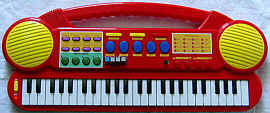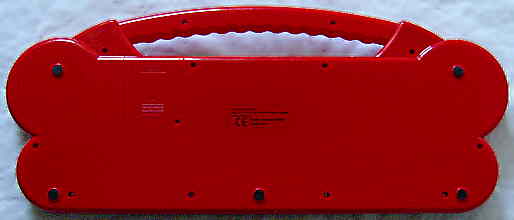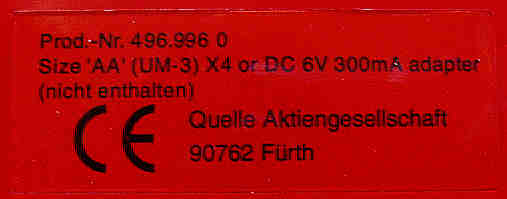 |
 |
| Quelle
496.996 0 |
small keyboard with 49 mini keys, digital lo-fi sound & lovely demos |
This seems to be a direct predecessor of the great K-Mark WP9019A1 keyboard. While its main voice has many similarities with the latter, it has neither accompaniment nor programmable rhythm, but instead there are 10 lovely arranged polyphonic demo melodies.
 |
 |
I don't know the genuine model name of this instrument; only on its bottom is the name of the German mailorder shop Quelle and the model number "496.996 0". On the PCB is the number "KM0043 PCB REV 2.0", where "KM" may stand for "K-Mark", the manufacturer of its more advanced successor K-Mark WP9019A1. Sound and behaviour of this instrument are very similar to it, thus I only describe here the differences.
 |
 |
polarity protection diode added. buttons for "fill in", "demo next", "demo loop" & "stop" added. pitch control potentiometer added.
All main voice sounds contains much aliasing noise that resembles a ring modulator and gives the instrument a quite unique bright and thin metallic timbre, that reminds to a mechanical musicbox or bright metal pipe organ ranks. Apparently the instrument originally played one octave to high by a wrong clock resistor; after adding a pitch knob and tuning down, the octave range of most sounds appears much more credible. Like with K-Mark WP9019A1, the main voice sounds are made from low resolution loop samples and attempt (with varying success) to simulate the timbre of what they are supposed to be, thus I only explain here the unusual ones. Beside "e-bass", none of the sounds include vibrato. Unlike WP9019A1, the piano here employs only 2 instead of 4 split points and thus has a less natural bass range. Most other sounds have no split points. The "bell" resembles a vibraphone without vibrato or a Rhodes piano; "e-piano" is a duller variant of it. The "guitar" resembles an acoustic one. The "violin" sounds way too static due to its short loop sample and thus rather resembles an organ. The "bass" is a unique sounding brassy, sonorous and dry synth e-bass, which reminds to Casio's consonant vowel synthesis "frog" sound (e.g. on Casio MT-60), but unlike the latter, the pitch howls up during the attack phase especially with low notes, which causes high octaves to detune against lower ones and thus squint in a lovely way similar like the famous Atari POKEY sound; this is especially noticeable when high and low notes play together. The "oggan" sounds like a metal pipe organ rank, which notes in adjacent octaves only barely differ. The "e-guitar" is a loop sample of a harsh distorted e-guitar tone, which does not decay and rather resembles bagpipes; it contains many disharmonic overtones, those make chords sound quite off. The "bassoon" is to harsh and also resembles bagpipes. The "xylophone" sounds fairly realistic, and its high notes resemble a quiet musicbox. The "harp" sounds to harsh and thin and resembles more a mandolin or the like.
Although the samples are different, the rhythms resemble My Music Center and thus sound quite thin. The OBS preset rhythm buttons immediately (re-) start their rhythm, but reset their tempo to default and the preset sound to "piano". To stop the rhythm, press "demo all". Interesting is that there is a quiet rhythmical beep of constant volume audible in the rhythms, which is like produced by unused LED output pins of the CPU.
Also the known useless record/ playback sequencer beeps this way during recording; as usual the monophonic thing looses its contents when anything but "rec play" is pressed, but very unusual is that this cucumber here even skips to record its 40th(?) note despite it stores some more afterward. Also any drumpad press deletes the sequencer contents.
There are a lot of lovely polyphonic demo melodies on this instrument; most of them are quite long and played in a virtuously arranged ragtime/ charleston piano style. Annoying is that you can only start with the first demo by pressing "demo all" and then wait until the other music tracks begin (like a CD player that has only a "play" button) despite the CPU supports a "demo next" button for quick selection as a keyboard matrix easteregg. The player can also play keyboard (monophonic) to the demos, which automatically mutes their melody voice for a bar, and you can also switch the preset sound.
The 10 demo melodies of this instrument are:
circuit bending detailsThe Quelle 496.996 0 keyboard is based on the single-chip CPU "KM0043S, REV 2.0".
keyboard matrixThe keyboard matrix is active high, i.e. inputs respond on +Vs. The matrix input lines are pin EF0..EF7, the outputs AB0..AB7 and CD0..CD1.
Add a button switch in series with a diode at CD1->EF2 for rhythm fill-in.
Add a button switch in series with a diode at CD0->EF0 for the "closed hihat" drumpad. (I didn't do this because the same sound is already played by a lot of other buttons (e.g. tempo +/-) and there is no rhythm programming on this instrument.
Add a button switch at AB2->EF0 to cycle through the demo melodies (one per button press); this is way more comfortable than the given "demo all" button, that always starts only with the first melody and then plays them all in a sequence.
Add a button switch at AB2->EF3 to play the accompaniment track of a demo in a loop. This was likely either a test feature or intended as a kind of "melody guide" play training (see Casio PT-82) or "one key play" (like with My Song Maker) that has a severe software bug. When any demo was started with the "demo next" button (not with "demo all"), this button mutes the main voice of that demo and repeats its current background accompaniment pattern in a loop. You can now manually play a monophonic main voice to this accompaniment loop, but nothing else. There is no way to step further to the next pattern (only to stop the entire demo).
Add a button switch at AB1->EF0 to stop running rhythms or demos. (The "demo all" button can be also used for this, thus the button is not necessary.)
pitch control (and shitshot?)The CPU module contains on its back some capacitors and for clock frequency control an 11 kOhm resistor (with mine 10 + 1 kOhm in series) against +Vs. Remove the resistors (at least the 10 kOhm one) and instead connect the clock output of the CPU through an 1 kOhm resistor (I used the given one) with the wiper of a 100 kOhm potentiometer. For a simple pitch control, connect its right end with +Vs of the CPU, and its left end with a 10 kOhm resistor against GND. Like with the My Music Center hardware family, the grainy bleeps of the time slice DAC get audible when pitch is turned very low, which can be used for tekkno. With my 1 kOhm resistor the clock line the CPU does not crash even with the pot fully turned against +Vs, thus possibly a lower resistor may be necessary for a shitshot function. (For safety reasons don't go lower than about 300 Ohm without testing the clock line current (should stay <1mA) and CPU temperature.) |
Question: Does anybody know the
original trade name of the Quelle 496.996 0 keyboard?
| removal of these screws voids warranty... | ||
 |
||
|
|